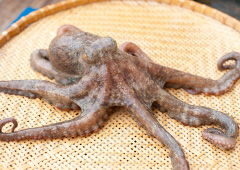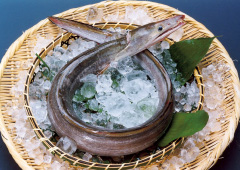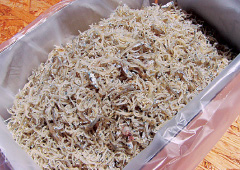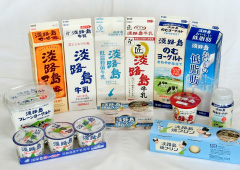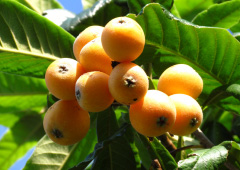Awaji Island Kuniumi Association
- Top
- Food & Speciality
Food & Speciality

Traditional sight in spring: Sun-drying ikanago (sand lance)
"Miketsukuni" is the state which is supposed to provide the food materials such as seafoods with the Imperial Court and Imperial Family from the Japanese ancient times to the Heian era. Rich in food materials like Wakasa and Shima states, Awaji Island delivered wide range of food materials to the Imperial Court. Surprisingly, in the section of Emperor Nintoku in “Kojiki”, the Japan’s oldest historical record, it is noted that even the daily drinking-water was brought to the Imperial Court from Awaji Island.
It may be said that the food materials of Awaji Island received an official guarantee from the Imperial Court. Up to now, the “Awajishima Brand” still gains much fame throughout Japan.
Brand Line up of Awaji Island
Awaji Beef
Tajima cattle bred on Awaji Island are the breeding cattle for Japan's most famous brands -- Matsuzaka Beef and Kobe Beef. Still today only the finest breeding cattle are selected for systematic mating on the island. Breeders aim constantly to preserve this excellent resource and further improve beef quality.
Red Sea Bream (Tai)
The red sea bream caught in the straits of Awaji Island are so well known throughout Japan that they have their own brands -- Akashi Tai and Naruto Tai. The port of Maruyama is famous for supplying red sea bream to the most recent three emperors: Taisho, Showa and Heisei.
Octopus
The octopus tastes delicious when caught in early summer as the fields of barley start turning yellow. Many ceramic pots thought to be used for catching octopus have been found on Awaji Island dating back to the Yayoi period (300 BC to 300 AD). Methods for catching octopus have changed little since that time.
Sea Eel (Hamo)
Sea eel, also called "pike conger," have an extremely strong life force. In the ages before refrigeration, it took an entire day and night to transport eels to Kyoto. But the eels were still alive upon arrival. In landlocked Kyoto, where it was difficult to acquire flesh seafood, sea eels were thus highly valued.
Sand Lance (Ikanago)
Sand lance drying under the sun is a springtime sight in the Inland Sea area. The fish's peak growing season is March to April. On Awaji Island, especially small sand lance known as "kona" are highly valued. These are the main ingredient in a tasty side dish known as "Ikanago-no-Kugini": tiny fish broiled in sweetened soy sauce with ginger.
Chirimen
Chirimen are semi-dried or fully dried baby sardines and other tiny fish, primarily anchovy fry. It also represents the major sea product in Awaji Island. Chirimen consisting of white anchovy fry of the highest class, selected and dried under the clear skies of Awaji Island, are especially tasty.
Three-Year Pufferfish (Fugu)
Fugu bred for close to three years at the port of Fukura at the southern tip of Awaji Island have gained wide attention. The water and weather conditions in Fukura are unparalleled, producing particularly delectable shirako, the large soft roe of the male fish.
Milk
According to ancient taxation records dating the year of 738, the Imperial Court procured milk products from Awaji Island, thought to be butter and cheese. Milk production on Awaji goes back that far in history!
Onions
The agricultural product that Awaji Island is perhaps most famous for is its onions. The onions grown on Awaji have a high sugar content and wonderful aroma. They have a milder bite than onions grown elsewhere, and feature soft fiber. Many products made with Awaji onions are also widely available, such as onion dressing and onion soup.
Lettuce
Lettuce grown on Awaji Island accounts for 90% of the lettuce consumed in Hyogo Prefecture. Between October and May, over 1,000 hectares on the island are planted with this major crop. Especially in winter, special agricultural methods are employed to increase the volume of the lettuce while keeping it tasty and light.
Mandarin oranges
Awaji Island provides an ideal climate for growing mandarins. The sunlight which is reflected off the water at the coast makes the mandarin oranges sweet and deep-flavored, and also make their acidity well-balanced.
Hand-stretched somen noodles
Somen noodles are thin white noodles made of wheat flour. Hand-stretched Awaji somen is made in Fukura, at the southern end of the island. In the coldest part of winter, the noodles are made using a time-honored method originated in Edo period, taking two days.
Loquats (biwa)
On Awaji Island, loquats are grown on sloped hillsides in well-drained soil unique to the area. The mountainside, which blocks the wind, combined with abundant sunshine produces high-quality, sweet loquats. Nada Biwa grown at the southern end of the island are a popular brand nationwide for the fine shape, soft flesh and sweetness of the loquats.



